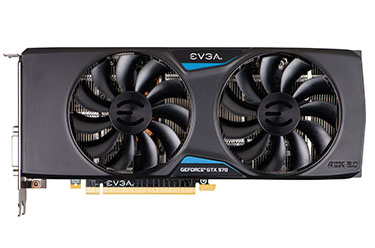Introduction
October 2014 saw EVGA release the GeForce GTX 970 Super Superclocked (SSC) ACX 2.0 (04G-P4-2975-KR) graphics card in very limited numbers through a handful of etailers in North America, Germany, and the Nordics.
Priced at $359.99, or $30 more than reference, the original SSC version's 1,190MHz core and 1,342MHz average boost speeds provided a significant in-game performance uplift over the bog-standard card.
EVGA has since updated the still-capable GeForce GTX 970 GPU by releasing a newer, cheaper SSC ACX 2.0+ model that's widely available now.
This enhanced GeForce GTX 970 SSC, known as 04G-P4-3975-KR, features the same elevated core clocks and standard memory speed as its short-lived predecessor but is equipped with a newer, more efficient cooler. EVGA says the second-generation SSC, priced at $349.99, or $10 lower than the outgoing model and same as the standard Superclocked, uses an improved heatsink for better heat dispersal that, one would assume, should lead to lower temperatures and associated noise output.
In detail, EVGA is upgrading this GTX 970's cooling by using a full-coverage memory and MOSFET cooling plate (MMCP) rather than the partial plate found on the last-generation For The Win (FTW) card. Such a move is claimed to reduce memory temperature by 14 per cent and, probably more relevant to the overclocker, keep the hot-running VRM MOSFETs 48 per cent cooler than on the same card bereft of MMCP technology. The present Superclocked ACX 2.0 card, 04G-P4-2974-KR, also has no such MMCP plate, mind.
Further, EVGA says it is now using a trio of 8mm heatpipes that run horizontally across the heatsink instead of the usual U-shaped arrangement found on other models, including the original Superclocked. EVGA believes the straight-across-the-block design offers six per cent better heat dispersal and lower thermal resistance. All good attributes for a reference-beating card.
Harnessing this extra performance potential, the GTX 970 SSC upgrades the circuitry to six power phases while adding 6+8-pin power connectors in concert with an overclocking-friendly Power Target figure higher than on the majority of the competition. This appears to be a card begging to be overclocked to GeForce GTX 980 levels, then.
Enthusiasts will likely appreciate the presence of twin BIOSes. The default shipping BIOS provides zero-fan support at temperatures up to 60°C, and flicking over to the second offers a more rigorous fan-speed profile better suited to overclocking. Pertinently, the second BIOS' fan remains switched on at all times, spinning at approximately 600rpm until the GPU temperature exceeds 40°C. Thereafter, it increases in speed linearly as the temperature increases to 80°C (2,000rpm), and then ramps up to a potential 4,500rpm when under the most silicon duress.
Build quality is up to the usual high EVGA standards and the overall presentation remains slick. Little touches such as damage protection for the PCIe connector and display outputs and well-written guides help keep the quality theme intact.
And providing a full overhaul of the 10.1in-long card, EVGA adds another couple of DisplayPort 1.2 outputs on the rear, augmenting HDMI 2.0, DVI and the usual DisplayPort 1.2, though, per Nvidia's specifications, a maximum of four can be used concurrently.
It's no secret that add-in card partners tend to recycle coolers in an effort to ameliorate increased research and development costs, which is entirely understandable, yet the upgraded ACX 2.0+ heatsink is one of the more robust propositions available.
One minor grumble is that EVGA doesn't provide a strengthening backplate on this model, unlike most of the premier competition, and while such an inclusion is more for aesthetics than improved performance, it's something the company should at least think about implementing on a non-FTW card.
EVGA's newer GTX 970 SSC is backed by a transferable three-year warranty that can be upgraded free of charge to five-year cover upon registration at EVGA.com before June 30, 2015. Note that the additional two-year cover is only available to the original purchaser of the card and through approved etailers in Europe.
Partner cards tend to offer performance above and beyond that stipulated by the GPU boost clock that EVGA sets at 1,342MHz. We found our sample card ran at an average 1,392MHz across six games with, as you will see later on, plenty of scope to go higher.
The £280 street price includes an electronic voucher for the eagerly-anticipated, upcoming Witcher 3: Wild Hunt as part of an Nvidia bundle.













